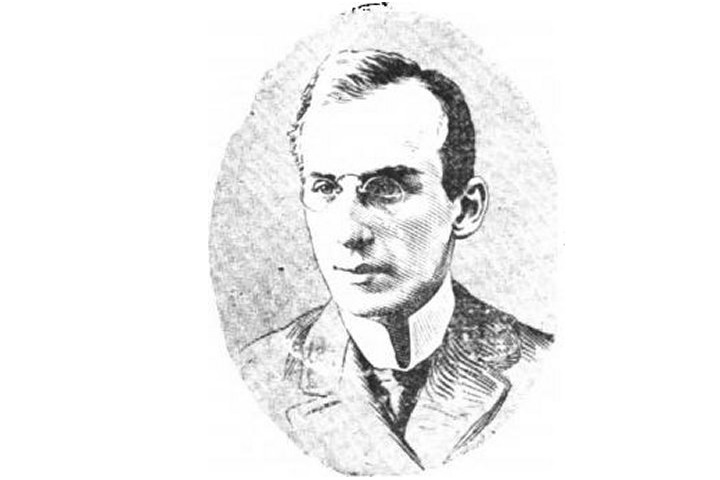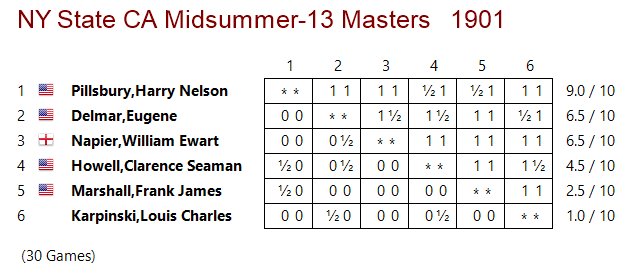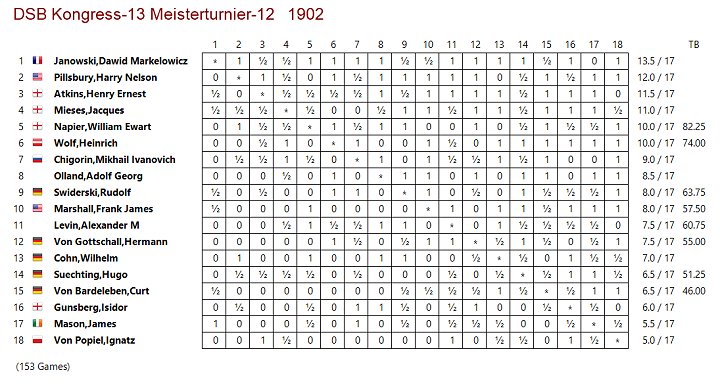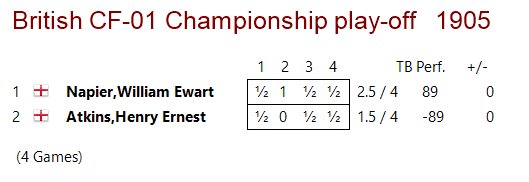


Perhaps, only in a collection of classic games can one come across William Ewart Napier today. His famous game against Emanuel Lasker in Cambridge Springs, 1904, seems about the only footprint he has left in chess history. Yet, he was a very strong master who far surpassed expectations of him as an amateur. He was a loss to chess when he left the game permanently for another career.
Napier was born in East Dulwich, Surrey, England on January 17, 1881. His parents migrated to the United States when he was five. From 1895, the Napiers lived in Brooklyn, and William met the best chess players of the country.
Napier scored his earliest successes in simultaneous games, beating, among others, Jackson Showalter, then the United States Champion. In 1896, he became a member of the Brooklyn Chess Club and won the club championship of that year. Later that same year, he played a race to seven match against Frank Marshall. Marshall, the New York State Junior Champion, was four years older than Napier, but Napier overcame Marshall’s edge in experience and reputation, dominating the match, 7-1. In a triangular tournament among Napier, Wilhelm Steinitz, and Samuel Lipschutz in 1897, Napier won one of his two games against Steinitz.

Traveling to Europe in 1899 to study music, Napier visited the chess clubs of London, Paris, and Berlin. He returned to the United States in 1900, establishing himself in Pittsburgh and running a column in the newspaper, Pittsburgh Dispatch. The following year, he finished joint second behind Harry Nelson Pillsbury in the New York State Chess Association Congress' master's event held in Buffalo, New York. Marshall, the other prominent American master participating in the double round-robin event, placed second to the last, four points below Napier.

Napier's success encouraged him to participate in international events. In Monte Carlo in February 1902, he placed 11th among twenty of the world's leading masters, but scored wins against David Janowski, Mikhail Chigorin, Jacques Mieses, and Adlof Albin. His game against Chigorin, in particular, won the tournament's brilliancy prize. Janowski had won the event's first edition in 1901.
In July that year, Napier finished a strong fifth in the 13th Congress of the German Chess Association in Hanover, Germany, behind the winner, Janowski, Pillsbury, Henry Ernest Atkins, and Mieses. This time, it was his win over Curt von Bardeleben that won the brilliancy prize. He also derailed Pillsbury in his fight for first place with Janowski, defeating him in their individual encounter.

Napier also participated in one of the greatest tournaments ever held on American soil, Cambridge Springs 1904. The event included all the leading players of the world, except Siegbert Tarrasch and Geza Maroczy. Napier's fellow-American, Marshall, unexpectedly won.
Pillsbury's game against the world champion, Emanuel Lasker, won the brilliancy prize, with Napier's own against John Finan Barry awarded the second prize. However, Napier's game against Lasker may have been the tournament's most memorable encounter. It is an immensely complex one, a labyrinth that has been analyzed and interpreted differently by generations of annotators. Modern computer analysis has found flaws in them, but it is as well-played as humanly possible.
Despite the loss, Napier considered the game the best he ever played. The story goes that Napier and Lasker proposed the game to the organizers for the brilliancy prize. Lasker supposedly told Napier: "It is your brilliancy, although I won."
%20-%20Kopie.jpg)
Napier sitting at the chessboard | Source: https://chesshistory.com/winter/extra/napier.html
Shortly after the Cambridge Springs tournament, Napier returned to Europe and played in the National Tournament of the City of London Chess Club of 1904. The field included experienced players such as Richard Teichmann, Joseph Henry Blackburne, and Isidor Gunsberg, but it was Napier who took first place on the strength of his 9 wins, 7 draws, and no losses.
Merely ten days after the London event, Napier participated in the 1904 British Championship in Hastings, where, by virtue of his English birth, he was entitled to take part. Napier tied for first with Henry Ernest Atkins after eleven rounds, both of them a point and a half ahead of Blackburne. The tie had to be broken with a four-game match between Napier and Atkins.

The British championship ended in September 1904, but the match took place in January 1905, more than three months later. The Yorkshire Post and Leeds Intelligencer, in its January 3, 1905 issue, announced: "At a meeting of the British Chess Federation in Hastings in August, the title of chess champion of England, together with a gold medal, could not be conferred as there was a tie between Napier and Atkins. These two masters have now again met at Hastings to decide the tie by a series of four games."
Prior to this meeting, Napier and Atkins played each other twice--once in Hanover 1902, and once also in the British Championship itself. As both games had ended drawn, the play-off promised to be a close one. Indeed, it was, with Napier scoring the lone win in the second game. Napier thus became the first British Chess Federation Champion. Atkins thereafter became one of the most dominant players in the history of the British Championship, becoming national champion nine times.

1905 proved to be Napier's last significant year in chess. He played two matches, one with Mieses, which ended drawn at 4-4, and another with Teichmann, which he lost, 5-1. He also played a Rice Gambit themed-match with his old rival, Marshall, which he won, 3-1. At 24, he then withdrew from competition and began a career in the insurance business. He became an American citizen in 1908 and rose to the vice-presidency of the Scranton Insurance Company. Later, he married Florence Gillespie, the niece of his competitor, Pillsbury, with whom he had two daughters.
According to Chessmetrics, Napier achieved his highest rating of 2662 in 1906, and reached a remarkable performance rating of 2725 in his 1905 themed match against Marshall. Yet, when he passed away at 71, his chess career was nearly forgotten.
Aside from being a strong chess player, Napier was also an excellent writer. He authored a book entitled "Napier's Amenities and Background of Chess-Play," published in three parts between 1934 and 1935. If he had continued playing, he would have been as witty and as highly quotable as Savielly Tartakower. Here are some quotations that appear in his book:
.jpg)
The quote above is often attributed to Napier, but as the chess historian Edward Winter said in an extensive and informative article about the origin of the quote, "we do not recall seeing it in Napier’s writings".
Napier was a huge loss to chess. If he kept competing, he would have peaked in the second to the third decade of the 20th century, chess' golden age. What more might he have achieved? As it was, his career was short, but he burned brightly and took himself as far as he could with his talent that was one of the finest of his period.
References
Games
Lasker vs. Napier, Cambridge Springs, Round 3, April 28, 1904
Napier’s famous game against Lasker. In a Sicilian Dragon, Lasker launches a kingside attack but leaves his king in the center. Napier breaks the center open and a tactical melee ensues.
Napier vs. Chigorin, Monte Carlo, Round 20, March 10, 1902
The game that won the brilliancy prize in Monte Carlo 1902. Napier’s central superiority combined with the open g-file leads to a decisive attack.
Von Bardeleben vs. Napier – Hanover, Round 10, August 1, 1902
Napier sacrifices a piece to leave Bardeleben’s King weak, and his pieces uncoordinated. He then exploits his initiative beautifully.
Barry vs. Napier, Cambridge Springs, Round 1, April 25, 1904
The game that won the second brilliancy prize in Cambridge 1904. Napier was a highly skilled positional as well, as this game shows.
Marshall vs. Napier, Brooklyn, New York, Round 1, October 8, 1896
Napier demolishes Marshall out of the opening.
Addendum: This is a slightly modified version of the original article that appeared yesterday, 19 October 2023. After publication, Edward Winter and Olimpiu G. Urcan were kind enough to point out some errors in the text, which have been corrected.
| Advertising |